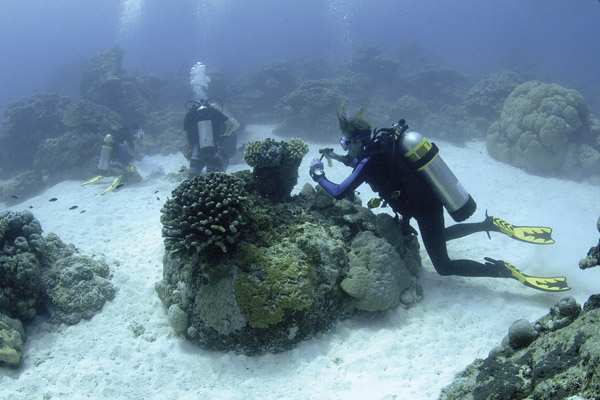Divers Study Micronesia Coral

In the late fall of 2012, researchers from Woods Hole Oceanographic Institution, the University of Maryland and the University of Hawaii at Manoa joined forces to conduct a month-long integrated study of coral in the Federated States of Micronesia, remote islands in the western Pacific. Three dive teams, each using different tools to achieve different objectives, traveled to developed, rural and uninhabited regions of the archipelago to study the corals.
Team one, led by Dr. Konrad Hughen of Woods Hole Oceanographic, searched out massive aggregations of Porites coral, colonial organisms that are superb recorders of historical sea conditions. Their chemical composition can tell researchers much about near surface temperatures dating back 500 years, helping us better understand climate change over the longer term. Team divers searched for the large Porites colonies on snorkel and SCUBA, often being towed at the surface behind a small boat to cover large areas. Once a candidate for sampling was selected, a two-person team worked in shallow water, often less than 20 feet (6m), with a saltwater power drill to extract core samples.
Team two, led by Dr. Amy Apprill of Woods Hole, working with Dr. Alyson Santoro from the University of Maryland, focused on the inter-species partnerships corals develop with microorganisms. Studying tissue samples collected from both healthy and diseased corals will enhance our understanding of the role these microbes play maintaining healthy coral colonies. The team consisted of three scientists and one divemaster, all diving in shallow water from a RHIB boat. Maximum depths were typically less than 60 feet (18m). Dr. Santoro was able to conduct an experiment concurrent with the sampling to study how coral species use and recycle nitrogen. Observing how nitrogen is used is key to understanding how such diverse communities can be supported in the relative desert of the tropical seas.
Team three, led by Dr. Greta Abey of the University of Hawaii, and Dr. Thierry Work from the National Wildlife Health Center of the US Geological Survey, recorded observations of the diversity, quantity and relative health of coral species and other cohabitating organisms. The surveys were exhaustively conducted along a transect of the seafloor utilizing a survey tape and a ‘quadrat’, a PVC square that defines a small area for study. The ability to conduct this kind of study in such a remote location will give researchers a baseline from which to gauge the health of reef ecosystems impacted by humankind.
Leave a Comment







